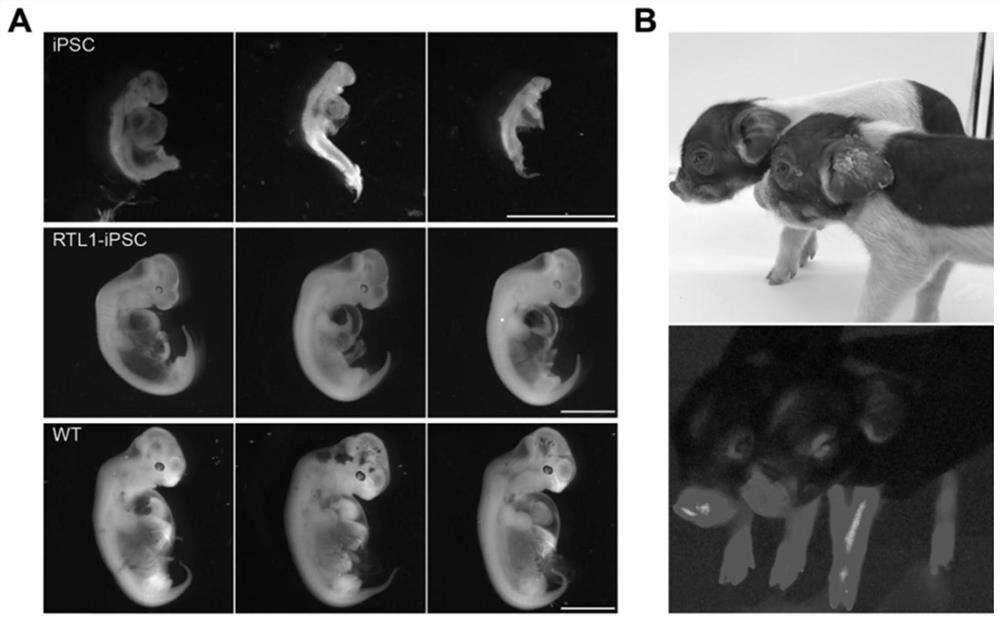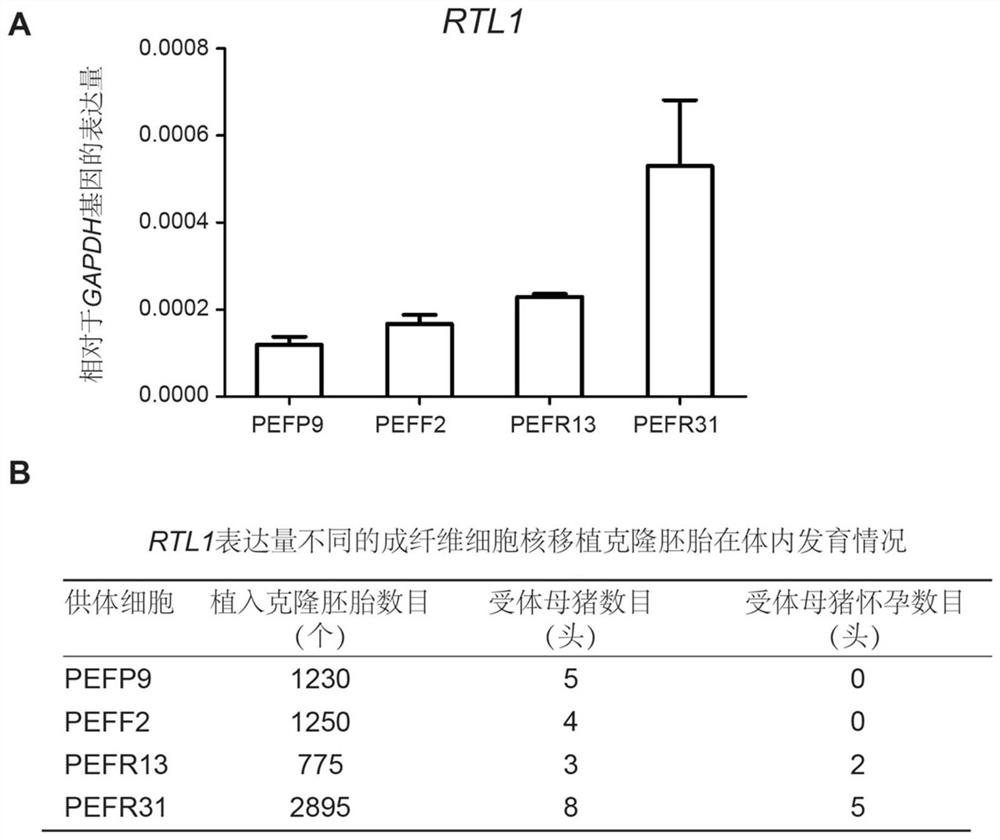A method for increasing the pregnancy rate of recipients of mammalian cloned embryos
A technology for cloning embryos and pregnancy rate, applied in the biological field, can solve the problems of unseen regulation of the pregnancy rate of mammalian receptors in cloned embryos, and achieve the effect of improving the pregnancy rate
- Summary
- Abstract
- Description
- Claims
- Application Information
AI Technical Summary
Problems solved by technology
Method used
Image
Examples
Embodiment 1
[0037] This example is used to illustrate that RTL1 gene silencing can cause developmental arrest of porcine iPS cell nuclear transfer cloned embryos after implantation.
[0038] In this example, the RTL1 gene (RTL1-iPSCs) was overexpressed in the pig iPS cells of nuclear transfer donors, and the RTL1-iPSCs that were consistent with the expression dose of RTL1 in fibroblasts were selected as donors for nuclear transfer by Q-PCR detection cell. We implanted RTL1-iPSC nuclear transfer cloned embryos into 10 recipient sows, and the results of ultrasound examination on the 25th day of pregnancy showed that 9 of them were pregnant. Among them, we compared the fetuses of two pregnant recipient sows with those of pig iPS cell clones without RTL1 overexpression. The first RTL1-iPSC nuclear transfer clone embryo recipient sow was pregnant with 7 RTL1-iPSC nuclear transfer clone fetuses, of which 4 had normal morphological characteristics and 3 were aborted. Another RTL1-iPSCs nuclear...
Embodiment 2
[0049] This example is used to illustrate whether the normal expression of the RTL1 gene not only affects the development of porcine iPS cell nuclear transfer cloned embryos, but also has a conservative regulatory effect on other types of pig nuclear transfer donor cell cloned embryos and cloned embryos of other species.
[0050] By analyzing a recent report on porcine fibroblast cloned pigs (Ruan et al., 2018), it was found that the expression of the RTL1 gene was at a stable low level ( Figure 4 ). At the same time, we also analyzed the transcriptome data of the recently published bovine allantoic tissue cloned by artificial insemination and nuclear transfer (Biase et al., 2016). Abnormal expression of the RTL1 gene appeared in 3 groups of nuclear transfer cloned bovine embryos. Considering that most of the nuclear transfer cloned bovine embryos were aborted at this time point, the expression analysis of the RTL1 gene may be the key to identify the efficiency of dairy cow c...
Embodiment 3
[0055] This example is used to illustrate that the RTL1 gene plays an important role in maintaining the developmental potential of mammalian pluripotent stem cells.
[0056]Although 12 years have passed since iPSC technology was first released in 2006, real iPS cells from large animals such as pigs, sheep, and cattle have not yet been obtained (Huang et al., 2011; Li et al., 2011; Wu et al., 2009). So far, only mouse iPS cells have been proved to have the ability of reproductive mosaicism and tetraploid compensation. Previous studies have pointed out that gene expression in the DLK1-DIO3 region is related to the pluripotency of mouse stem cells (Liu et al., 2010; Stadtfeld et al., 2010), but the specific genes or mechanisms have not yet been determined. We analyzed the relevant data on stem cell research published before (Chang et al., 2014; Guo et al., 2016; Li et al., 2017), the expression of RTL1 can be used as a marker for evaluating the developmental potential of mammali...
PUM
 Login to view more
Login to view more Abstract
Description
Claims
Application Information
 Login to view more
Login to view more - R&D Engineer
- R&D Manager
- IP Professional
- Industry Leading Data Capabilities
- Powerful AI technology
- Patent DNA Extraction
Browse by: Latest US Patents, China's latest patents, Technical Efficacy Thesaurus, Application Domain, Technology Topic.
© 2024 PatSnap. All rights reserved.Legal|Privacy policy|Modern Slavery Act Transparency Statement|Sitemap



